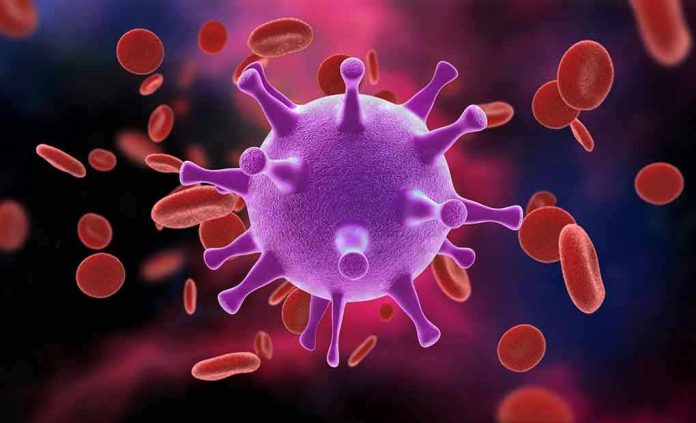
One molecule, lurking in a laboratory, may soon decide whether millions live or die in the antibiotic age—and almost no one outside science saw it coming.
Story Snapshot
- Scientists at the University of Liverpool unveiled Novltex, a new antibiotic class 100 times stronger than current drugs against deadly superbugs.
- Novltex targets lipid II, an immutable structure in bacterial cell walls, raising hopes it can outmaneuver resistance for years to come.
- The discovery arrives as antimicrobial resistance claims millions of lives annually, with few new antibiotics entering the pipeline.
- Early results show Novltex is potent, non-toxic, scalable, and poised for animal and clinical trials—potentially changing the course of global medicine.
Superbugs: The Unseen Threat That Won’t Wait
Hospitals worldwide are besieged by infections that laugh in the face of our best antibiotics. Every year, multidrug-resistant (MDR) bacteria like MRSA and Enterococcus faecium kill nearly five million people, a fact that makes the World Health Organization rank antimicrobial resistance (AMR) among the greatest threats to human health.
For decades, scientists have watched as new drugs slowed to a trickle, while superbugs evolved at high speed—leaving patients and doctors with shrinking options and growing fear. The stakes could not be higher: without new solutions, routine surgeries and minor wounds could become death sentences.
In this crisis, Novltex emerges as a potential turning point. Developed by Dr. Ishwar Singh’s team at the University of Liverpool after years of research into synthetic analogs of teixobactin, Novltex’s arrival was announced in September 2025.
The compound’s power lies not just in its raw strength—up to 100 times more potent than current antibiotics—but in its target. Novltex attacks lipid II, a vital building block of bacterial cell walls that cannot mutate without destroying the bacteria themselves. In practical terms, this means bacteria have almost no escape route, making Novltex potentially “resistance-proof” in a way that has eluded medicine for generations.
The Science and Stakes of Novltex
Antibiotics were once called miracle drugs, but overuse, misuse, and a lack of new discoveries have dulled their shine. Most new drugs are simply tweaks on old formulas, and bacteria quickly learn to dodge their effects. Novltex’s innovation is its modular, synthetic design.
The compound can be rapidly optimized and produced at scale—a crucial feature when time and supply lines can mean the difference between containing an outbreak and global catastrophe. Early lab results are promising: Novltex wipes out superbugs at vanishingly low doses and shows no toxicity in human cell models, giving scientists hope that it can leap into animal trials and, before long, the wards where it is most needed.
Before Novltex, the last big leap forward was teixobactin, discovered a decade prior. Since then, advances in AI and computational chemistry have helped researchers like Singh’s team search deeper and build better molecules. Yet no previous candidate has combined efficacy, safety, and scalability quite like Novltex. Its very existence challenges the fatalism that has crept into AMR discussions, offering a plausible path to new treatments for the world’s most stubborn infections.
What Happens Next: Opportunities and Open Questions
Animal studies are slated for late 2025, with clinical trials on the horizon if preclinical data holds up. The pharmaceutical industry is watching closely, as Novltex’s modular synthesis could spark renewed investment in antibiotic research—an area long neglected due to high costs and uncertain returns.
Global health organizations, policymakers, and regulators will all play pivotal roles in shepherding Novltex from laboratory to bedside. The potential rewards are immense: effective new antibiotics could ease the burden on health systems, save countless lives, and restore confidence in modern medicine.
Yet, no discovery, no matter how dazzling in the lab, is guaranteed to perform in the chaos of real-world infections. Experts caution that laboratory potency does not always translate into clinical success.
Resistance has a way of finding cracks in even the toughest armor. The story of Novltex is, so far, a story of promise—but the next chapters will be written in the unpredictable world of clinical trials, regulatory scrutiny, and, perhaps, the first patients to receive the drug when all other options have failed.
Sources:
MedicalXpress: Scientists discover powerful new antibiotic class to tackle deadly superbugs
IFLScience: New Powerful Antibiotic That Kills Superbugs Found Hiding Deep In A Chinese Mine
MIT News: Using generative AI, researchers design compounds that can kill drug-resistant bacteria
News-Medical: Halicin: The AI-Discovered Antibiotic That Fights Superbugs
miniPCR: Fighting Superbugs with AI: A New Hope in Antibiotic Discovery







